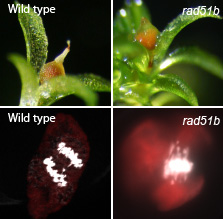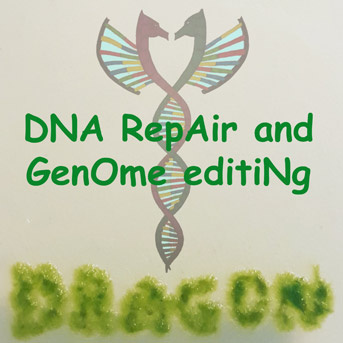The DRAGON team wants to better understand the mechanisms of DNA repair in plants and decipher the processes that govern the choices between the different repair pathways in the cell.
This knowledge should help optimizing the use of genome editing in plants, a field in full development and which still requires improvements.
Biological Question
The different members of the DRAGON team are involved in projects concerning DNA repair or targeted modification of genes in plants. We try to better understand the mechanisms of DNA double-strand break repair in the model moss Physcomitrella patens. This knowledge should help optimizing the use of new tools for genome modification and gene function analysis in this model plant (based on CRISPR-Cas9). Finally, our objective is to transfer the data obtained from Physcomitrella patens in the model plant, Arabidopsis and, in the longer term and through collaborations, to plants of agronomic interest (tomato, potato, camelina, N. benthamiana) to allow targeted modification of genes in these species.
The different members of the DRAGON team are involved in projects concerning DNA repair or targeted modification of genes in plants. We try to better understand the mechanisms of DNA double-strand break repair in the model moss Physcomitrella patens. This knowledge should help optimizing the use of new tools for genome modification and gene function analysis in this model plant (based on CRISPR-Cas9). Finally, our objective is to transfer the data obtained from Physcomitrella patens in the model plant, Arabidopsis and, in the longer term and through collaborations, to plants of agronomic interest (tomato, potato, camelina, N. benthamiana) to allow targeted modification of genes in these species.
Models, tools and methods
The principal plant model used by the DRAGON team is the moss Physcomitrella patens. In this plant model we work mainly at the cellular level and use in protoplasts for DNA transfection experiments. We have a reverse genetic approach that allows us, through the study of mutants,
The principal plant model used by the DRAGON team is the moss Physcomitrella patens. In this plant model we work mainly at the cellular level and use in protoplasts for DNA transfection experiments. We have a reverse genetic approach that allows us, through the study of mutants,

to analyze the implication of candidate genes in the stability of the genome of this moss. Studies to understand the involvement of these genes in DNA double-strand break repair are based on the use of CRISPR-Cas9 genome editing tools. For this, a reporter system of DNA repair efficiency has been established based on the use of the APT gene.

This reporter system is also used to test and optimize new editing tools such as basic editing or prime editing. These tools, once validated in the Physcomitrella patens model, are used to carry out gene editing in other model plants or crops.
Societal and economical impacts
The work of the DRAGON team consists, on the one hand, in the acquisition of knowledge about the modes of DNA repair in plants and their commonalities and specificities compared to other organisms. On the other hand, our research aims to better understand the molecular basis of the mode of action of the new tools of genome editing. From this point of view, our work must contribute, first, to a better mastery of these tools, which may well be unavoidable for the production of plant varieties of the future, and, second, must inform the necessary expertise to reflect on the potential of these new technologies, on the ethical issues that are attached to them, and on the regulation of the products that come from them.

Leader:
Fabien Nogué